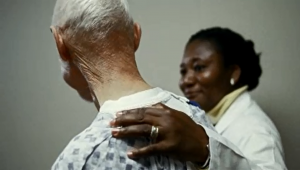Clinical
Division of General Medicine, Geriatrics and Palliative Care:
CLINICAL
Clinical productivity and revenue have risen significantly over the past four years, with more than half of division faculty achieving in excess of the 65% UHC productivity target, and more than a third in excess of the 80th percentile. In addition, the division has achieved 19.5% growth in outpatient volume since FY 2010.
General Medicine
The General Medicine section, led by Mohan Nadkarni, focuses on the care of adults ages 18 and over. It emphasizes preventive care and the fostering of long-term relationships between patients and physicians. University Medical Associates (UMA), led by Ira Helenius, conducted 33,352 patient visits in FY 2014, while serving as the continuity practice for all 100 Department of Medicine (DOM) medical residents. The largest of the division’s primary care practices, UMA is located on the main campus of the UVA Health System and has 19 dedicated internists. In conjunction with the DOM residency program, the UMA practice recently converted to a 3+1 scheduling model, which includes three blocks of inpatient rotations alternating with a dedicated block in the outpatient setting. This change, along with the implementation of the “firm” system, enhances continuity of care for patients and helps ensure a more consistent learning experience for residents, and their exposure to the entirety of the office-based ambulatory curriculum.
While continually striving to expand its services, UMA maintains some of the highest quality indictors in the state. These currently include pharmacy, podiatry and an anti-coagulation program that provides services for approximately 250 patients on oral anticoagulant therapy. UMA has also developed an insulin titration project in which medical students contact diabetes patients weekly in order to improve their glucose control.
The division’s other major Charlottesville-based clinic, University Physicians Charlottesville (UPC), consists of seven internists located in the Fontaine Research Park. Led by Ken Ballew, the UPC conducted 12,729 visits in the past year, and continues to expand its ambulatory internal medicine presence. University Physicians Orange (UPO), with six internists, provides clinical care to a largely rural population north of Charlottesville. Lien Dame serves as its medical director. UPO conducted 16,344 patient visits in FY 2014; and plans are in place to add an advanced practice nurse in the fall of 2014.
Hospital Medicine
George Hoke, head of the Hospitalist program since its inception in 2007, has worked tirelessly to ensure it provides seamless, coordinated care at both UVA Hospital and the Transitional Care Hospital. In April 2014, Clint Merritt joined the Hospitalist team as its medical director. Dr. Merritt did his Internal Medicine residency at UVA from 2000-2004, serving as a chief resident in his final year; after completing his residency, he joined the Hospital Medicine program at Augusta Medical Center in Fishersville, Virginia. He directed the program there during the two years prior to his return to UVA.
Dr. Merritt assumes the medical director role during a period of rapid growth for the Hospitalist program: it has tripled in size over the last two years, adding nine new hospitalists in FY 2014; an additional six are slated to come aboard in FY 2015.
The Hospitalist program provides direct inpatient care on the general medicine wards, as well as consults through the General Medicine Consult Service and Surgical Preoperative Assessment Service. In conjunction with the latter service, they conducted 283 visits on an outpatient basis.
The Hospitalist program, which has an average daily census of 10 patients, maintains outstanding quality statistics and a demonstrated reduction of mortality rates as compared to other clinical services. In FY 2014, the Hospitalist staff:
- facilitated 22,933 patient encounters at UVA Hospital, and
- provided medical care to a total of 305 new admissions at the Transitional Care Hospital.
Hospitalists serve on numerous quality-related committees, including those focused on glycemic control, inpatient redesign, sepsis, catheter-associated urinary tract infections, pharmacy and therapeutics, patient progression, and opioid safety.
The team has been instrumental in establishing UVA Health System’s new Transfer Center, which coordinates physician referrals and patient transfers. Hospitalists now field transfer requests for patients who will be placed in general medicine, gastroenterology, cardiology, hematology-oncology, and plastic surgery units; they also obtain clinical updates for general medicine patients who must wait more than 24 hours for transfer. These procedures ensure a more coordinated transition of care.
The Hospitalist group leads the Hospital Medicine firm, one of four General Medicine teaching teams; the firm serves as a training ground for future hospitalists.
Geriatrics
The UVA Health System, in collaboration with Riverside PACE and the Jefferson Area Board for Aging (JABA), officially launched a “Program for All-Inclusive Care for the Elderly,” known as Blue Ridge PACE, in March 2014. This comprehensive medical and social day-care program provides supportive services for nursing-home-eligible patients so that they can remain at home and be cared for by their families with the assistance of strong community support. Families work closely with the PACE interdisciplinary care team to determine patients’ needs and structure their care. Geriatrics section head, Mark Newbrough, is the medical director for Blue Ridge PACE.
The Geriatrics section also operates three well-established community-based practices in the Charlottesville area that provide outpatient, long-term, and home-based care: Colonnades Medical Associates (Diane Snustad, medical director); Westminster Canterbury of the Blue Ridge (Seki Balogun, medical director), and University Physicians at JABA (Laurie Archbald-Pannone, medical director). The three practices together conducted 4,054 patient visits in the last year. Geriatric faculty also serve as medical directors for two assisted-living facilities in the area: Martha Jefferson House (Seki Balogun) and the Colonnades Health Care Center (Diane Snustad).
Palliative Care
Palliative care is an interdisciplinary approach to treating seriously ill patients, particularly those with chronic, progressive life-limiting illnesses. The Palliative Care Service at UVA, led by section head Leslie Blackhall, is one of the oldest and most comprehensive in the country. Services are provided to patients in both the hospital and outpatient settings, and at both UVA Hospital and the Transitional Care Hospital. Palliative Care consults, available seven days a week, focus on symptom management and advance-care planning.
In the outpatient setting, the Palliative Care Clinic at the Emily Couric Clinical Cancer Center serves cancer patients at all stages of illness, including those with curable cancers and survivors with symptoms related to their treatment. Palliative care clinicians, in conjunction with oncology colleagues, strive to help patients with advanced cancer achieve the highest possible quality of life, through aggressive pain and symptom management and provision of psychosocial and spiritual support. Funded by a CMS Innovation Award, palliative care clinics are offered five days a week, with evening and weekend call coverage; services for non-cancer patients are also available. Expansion of services in the Culpepper region is planned for FY 2015.
Quality & Patient Safety
Under the direction of John Voss, the Department of Medicine’s Vice Chair for Quality and Safety, the division has advanced numerous safety initiatives. In FY 2014, division-wide morbidity and mortality conferences increased from four to six meetings a year. With leadership responsibility rotating among GMGPC sections, the conferences cover a range of topics; recently, these have included appropriate indications for consult; transporting and managing patients admitted from outlying locations; managing atypical UTIs; protocols for inpatient sepsis; and narcotic contracts for pain management. Issues identified during these meetings are tracked for follow-up by assistant quality director Tammy Schlag.
Together with UMA medical director Ira Helenius, and as part of UMA’s “Patient-Centered Medical Home” initiative, John Voss and Tammy Schlag developed and helped implement clinical care guidelines for treatment of some common diseases, including diabetes, hypertension, and hyperlipidemia, and also established disease registries for patients with diabetes, hypertension, and heart failure. The registries are being utilized by UVA residents when designing their quality improvement projects, a required element in their ambulatory curriculum.
UVA Health System’s “Q17” safety priorities are 17 measures for improving patient safety and reducing morbidity and mortality; the division’s primary care and geriatric clinics have excelled in two of those measures, according to recent data: rates of influenza and pneumococcal vaccinations.
George Hoke, section head of the Hospitalist program, has helped lead the effort to establish UVA Health System’s new Transfer Center, which coordinates physician referrals and patient transfers. Hospitalists now field transfer requests for general medicine, gastroenterology, cardiology, hematology-oncology, and plastic surgery patients, and obtain clinical updates for general medicine patients when they must wait more than 24 hours for transfer. These procedures ensure a more coordinated transition of care.
With support from a CMS Innovation Challenge grant (“Making My Course Better: Proactive Palliative Care and Palliative Radiation in Patients with Advanced Cancer”), and in collaboration with colleagues from Hematology-Oncology, the Cancer Center, and Public Health Sciences, Leslie Blackhall has led a multipronged effort for improved palliative care, including development of an informatics infrastructure that supports improved clinical decision-making and monitoring; expansion of supportive services that allow for early identification of needs and improved integration of care over time; and streamlining workflows for palliative treatment of patients with bone metastases.
The Medicare and Medicaid Electronic Health Record (EHR) Incentive Program provides financial incentives for “meaningful use” of certified EHR technology to improve patient care. To receive an EHR incentive payment, providers must meet thresholds for “meaningful use” for a number of objectives. In FY 2014, 100% of eligible GMGPC faculty met the EHR “Meaningful Use” benchmarks, thus qualifying for the incentive payments.



